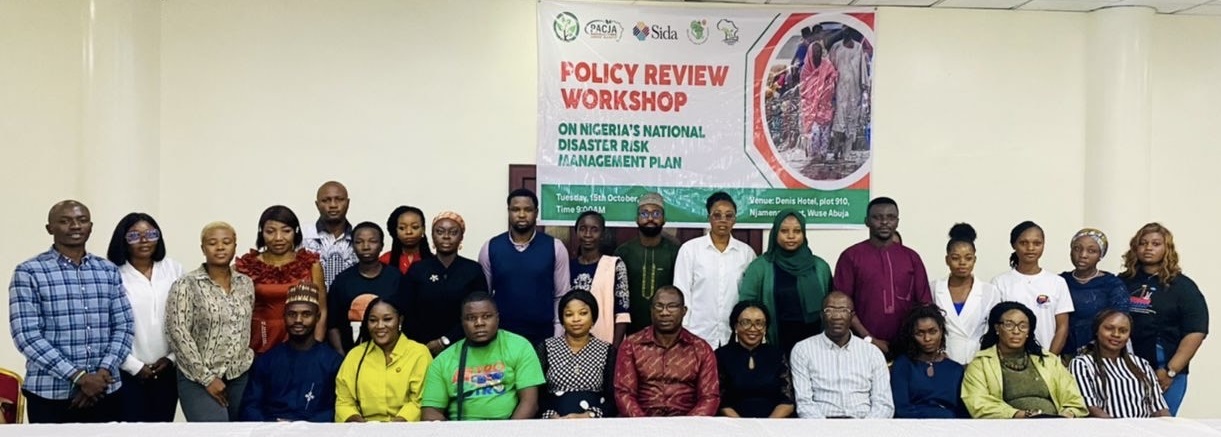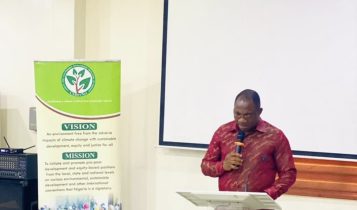
Written by: Mariam Idris
Climate and Sustainable Development Network (CSDevNet) held a workshop bringing together CSOs, CBOs, Government and other relevant stakeholders to review Nigeria’s policy framework on Disaster Risk Management, aiming to provide autonomy to the state government to support and strengthen vulnerable communities, individuals, businesses and institutions to minimize the adverse effect of climate-induced disasters in Nigeria, thereby enhancing the ability to prevent, prepare, respond to and recover from disasters across the country. The event was held in Abuja on Tuesday 15th of October 2024.
The National Network Coordinator of CSDevNet, Mr. Abuh M. Stephen, represented by Mr. Paul Gwumapan Joseph, the Program Officer, delivered opening remarks at the Policy Review Workshop on Nigeria’s National Disaster Risk Management Plan.
He emphasized the importance of collaboration in addressing climate-induced disasters, which are increasing in frequency and intensity due to climate change and rapid urbanization.
To effectively respond to these disasters, Mr. Joseph stressed the need for empowering ourselves with knowledge and tools for disaster preparedness, response, and recovery. The workshop aims to review Nigeria’s current disaster risk management policies, identify gaps, and foster collaboration to enhance community resilience.

Representing the Director General of National Emergency Management Agency (NEMA) – Mrs. Zubaida Umar, Mr. Tony Ephraim expressed profound gratitude of the DG to the Network.
He noted that, the Importance of Disaster Risk Management in Building Climate Resilience in Nigeria cannot be overemphasized.
Hence, cognizance to the effects of the global Climate Change, “the Workshop is apt and auspicious as it underscores the need for all stakeholders’ participation and commitment”.
We are at a crossroads. Climate change is undermining the ability to achieve the 2030 Agenda for Sustainable Development, including the Sendai Framework for Disaster Risk Reduction/Management.
NiMet will continue to build climate resilience in Nigeria which requires a multifaceted approach to disaster risk management. By prioritizing Disaster Risk Management, the country can safeguard its communities, promote sustainable development and mitigate the adverse effects of climate change. Collaborative efforts among government, civil society and local communities are essential for fostering a resilient future. Said Mr. Tony Ephraim.
Mr. Pirfa Venmak Nimyel representative of the Nigerian Metrological Agency (NiMet) gave a goodwill message stressing the importance of having a National Disaster risk Management Plan document that will guide on early warning and response system.
He noted that NiMet will always deliver on it mandates to provide accurate and prompt weather reports to safeguard lives and activities cutting across different sectors like agriculture, health, aviation, environment, telecommunications, transportation amongst others.
He said “Sharing knowledge with positive minds to put up a document to reduce the problems in our society that is ravaging lives and property cannot be de-emphasized”.
Speaking further Mr. Pirfa indicated that, NiMet produces seasonal climate prediction every year which is accessible to the public every February. The documents contain onset, cessation and length of rainfall. In his words “Nimet is ever willing to synergize NGOs, CSOs and government agencies to have health and safe Nigeria”.
In conclusion, CSDevNet’s Programme Assistant Mariam Idris noted that the turnout of participants shows significant progress in the inclusion of women in climate discourse. The turnout proved that the fact women are now interested in climate discussion especially around policies in climate initiative that addresses the need of the vulnerable communities.
The following recommendation were made:
- Backup dams should be constructed to checked issues of water release from bigger dams that leads to flooding in communities.
- Enhanced awareness and understanding of disaster management needs to be created especially in frontline communities.
- Establish inclusive frameworks that involve frontline communities in the decision-making and drafting of DRM policies. These policies should reflect the needs and experiences of those most affected by climate impacts.
- Collaborate with local governments and authorities to ensure that national disaster risk management (DRM) policies are adapted and implemented at the state and local levels, with a focus on the interests of vulnerable populations.
- Focus on creating actionable, time-bound disaster management measures rather than prioritizing state autonomy. Achieving disaster preparedness within limited timeframes should be a key objective, with clear benchmarks for success.
- Develop mechanisms to ensure that vulnerable communities and state authorities have better access to information on disaster predictions and early warnings. This could include improving the technology and communication channels for disseminating such information.
- Newly elected local government officials should be actively involved in conducting and understanding the risk assessments of their communities to better prepare for disasters. This engagement should be an essential part of their leadership agenda.
- Identify states without established or operational SEMA/LEMA boards and map out the gaps. Encourage and support these states in constituting their SEMA boards to improve their capacity to respond to disasters.
- Advocate for reduced bureaucratic delays in the establishment and operation of SEMA boards. There should be more focus on addressing local challenges rather than concerns about autonomy, as no laws prohibit the establishment of SEMA boards.
- Encourage states to work collaboratively with the National Emergency Management Agency (NEMA) and local emergency management agencies to create a cohesive and effective disaster risk management framework.
- Government should be intentional about hazard resistance structures, priotising housing, roads and power supply at the local level.
- Use of social media and content creation to transmit information locally.
